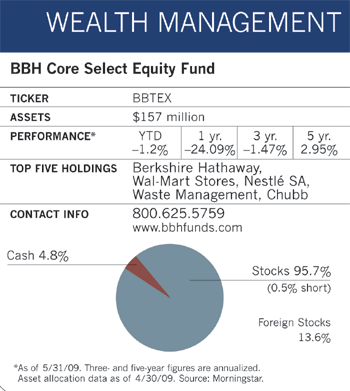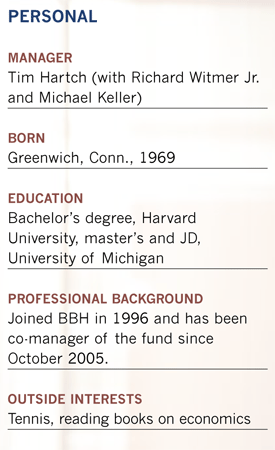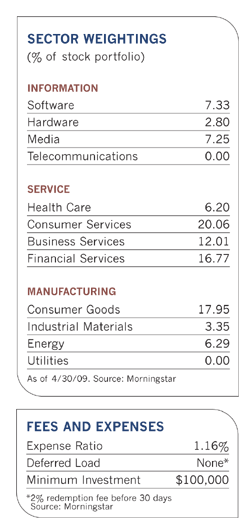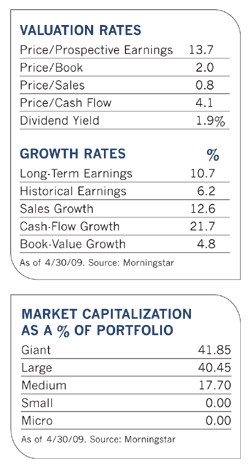Billing itself as the oldest and largest partnership bank in the U.S., Brown Brothers Harriman is as steeped in tradition as the Ivy League schools most of its top executives graduated from. So the BBH Core Select Equity Fund, which draws about 90% of its assets under management from principals or clients of the venerable Wall Street bank, carries a whiff of exclusivity.
But when it comes to finding resilient stocks, fund manager Tim Hartch looks for workhorse companies with loyal customers and more broad-based appeal. "Many investors do not fully appreciate the importance of customer loyalty," says the 39-year-old Harvard graduate. "But when you combine loyalty with a have-to-have product, you get a company that is going to thrive in good times or bad."
Hartch says high customer retention rates give companies more recurring and predictable revenue streams, more sustainable growth, higher profit margins and an ability to plow money back into their businesses. Companies with repeat customers also enjoy a higher profitability per client since they do not have to spend as much on advertising or highly compensated sales staff.
He points to Costco's loyal customer base of 17 million retail members and 5 million business members who renew their memberships at extraordinarily high rates, despite membership fees that are substantially higher than those of other warehouse clubs. Each club and member generates substantially higher sales than those of competitors, which is evidence of their perceived value. Repeat business is one reason the fund holding has been able to more than quadruple profits over the past ten years while incurring relatively little debt, Hartch says.
Customer loyalty isn't as easy to measure as more solid financial metrics. Because financial accounting typically requires companies to expense customer service costs, balance sheets and income statements may not reflect the full value of a company's loyal customer base. And while companies may discuss customer retention rates in their financial statements, those numbers are typically not audited and may not be disclosed. So Hartch talks to managers as well as competitors to get to the numbers he's looking for. He'll also try to get independent verification by analyzing the nature of a company's business and how easy it is for customers to walk away.
Many times, a company's customers are locked in, so it can draw a captive revenue stream from them. BBH co-manager Michael Keller, who specializes in technology securities, says fund holding Intuit, for example, has a product consumers find difficult to extricate themselves from. Someone who moves from QuickBooks or TurboTax to another system has to input a lot of information all over again, and that greatly discourages them from trying something else. The stock has been one of the fund's better performers so far this year.
Other companies in the portfolio also have an iron grip on their customers for a variety of reasons. Human resources company ADP, for instance, has won a steady stream of revenue because of the complexity and cost its customers face by switching payroll processing functions. Another holding, trash and waste removal concern Waste Management, has seen its stock fall significantly because of declines in the construction business. But at the same time, it is expensive to move garbage over long distances, and that gives the company a lock on local contracts and significant pricing power, even in a weak economy.
Other companies in the portfolio boast strong brand franchises, like those established by Nestle and Coca-Cola, that help secure a steady and loyal customer base.
Discounts Still Attractive
Hartch and co-managers Keller and Richard Witmer also look for other attributes, such as stock prices that fall below their estimates of companies' intrinsic value. Those estimates consider future cash flows, possible downside scenarios and other measures of resiliency and financial health. Other favorable characteristics they look for in companies include strong balance sheets, high returns on invested capital, leadership in a healthy industry and ample cash flow. The managers buy when discounts are attractive and plan to invest for five years, though they may sell sooner if a stock appreciates over intrinsic value or if their original premise about the purchase falls through.
The top ten holdings saw their widest discounts in March, when they traded at a little over half their intrinsic values. By May, the markets had improved and these portfolio stocks were trading at 60% to 65% of their intrinsic values. While those levels were not as generous as the March discounts, they were still much wider than the 20% discounts that prevailed at the beginning of 2008.
"There are times when investors need to choose between high quality stocks and lower quality stocks that are cheaper," he says. "The market downturn has eliminated that either-or decision and we've been able to pick up some great franchises at great prices." He adds that most of the companies in the portfolio are not experiencing significant declines in revenues or earnings, despite the severity of the current recession.
The fund typically holds 25 to 30 stocks with market capitalizations of at least $5 billion, and the top ten positions typically account for 45% to 50% of assets. The concentrated portfolio, drawn mainly from the S&P 500 index, reflects Hartch's conviction in his investment choices and the fund's ability to outperform the indexes. "If the stock market is generally expensive, owning a basket of 500 or even 1,000 names won't protect you from a broad market decline. And the problem is worse with index funds because they own more of companies after they have risen in value and less when they have declined."
Index fund investors discovered the dangers of overvaluation in 2000, when the S&P 500 dropped 47% and the NASDAQ fell 78% from peak to trough. "The equity investors who did best during the period invested in the subset of public companies that were still reasonably valued on an absolute basis," he observes.
Concerns about valuations as well as credit issues prompted the team to abandon banks as well as bond insurers MBIA and AMBAC three years ago. While the move occurred years before the fallout, the absence of bank stocks helped steady returns in 2008, when BBH Core Select became Lipper's top performing large-cap core fund.
Like other funds at the more conservative end of the equity spectrum, BBH Core probably wouldn't benefit as much from a roaring comeback in the market's most beaten-down sectors as some of its competitors would. "Given the kinds of businesses we own, we tend to see our best relative performance in down or sideways markets," says Hartch.
Core Select has participated in this year's rally, although some holdings have struggled. Aflac, which provides supplemental health and disability insurance in the U.S. and Japan, has a healthy insurance business and some of the highest renewal rates in the industry. But the value of some holdings in its investment portfolio has plunged, raising concerns about the company's ability to maintain acceptable statutory capital ratios. The stock plummeted nearly 57% in the first quarter, though Hartch says that Aflac's earnings and ability to raise additional capital from premiums should offset losses from its investment portfolios.
Berkshire Hathaway, the fund's largest position, suffered a setback in March when Fitch lowered its coveted AAA credit rating on the company to AA+. The rating agency cites, among other factors, the "key man risk" of the company (it's run by investing legend Warren Buffett), as well as declines in Berkshire's investment portfolio. Some observers have questioned whether Buffett's "buy and hold" strategy still works in today's market.
But Hartch says the company's strategies are as sound as they were before the crash, and that Berkshire Hathaway's insurance and utilities units are doing "extraordinarily well." Company subsidiary Geico has more than doubled its market share over the last decade as consumers switch from other, more expensive auto insurers to save money. The pricing power at reinsurance subsidiary General Re is also growing stronger, while Berkshire Hathaway's highly liquid balance sheet and modest borrowings add to its appeal.
BBH holdings Dell and Liberty Interactive have also seen significant sales and earnings declines. But their share prices have fallen so much that there is still a large gap between their intrinsic values and share prices, according to Hartch.
On the other hand, some holdings, many with high brand name recognition, have realized better-than-average performance. The fund has sizable positions in food and beverage makers such as Nestle, Coca-Cola, PepsiCo and Cadbury, whose products have very little competition from products of privately held companies. These companies still expect to generate revenue growth this year, despite economic weakness.
Four retailers in the portfolio-Wal-Mart, Costco, Walgreen and Bed Bath & Beyond-are reporting somewhat positive revenue growth and are faring better than the retail sector as a whole. These companies, which represent all of the fund's retail holdings, account for about 14% of its assets.



